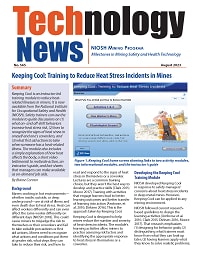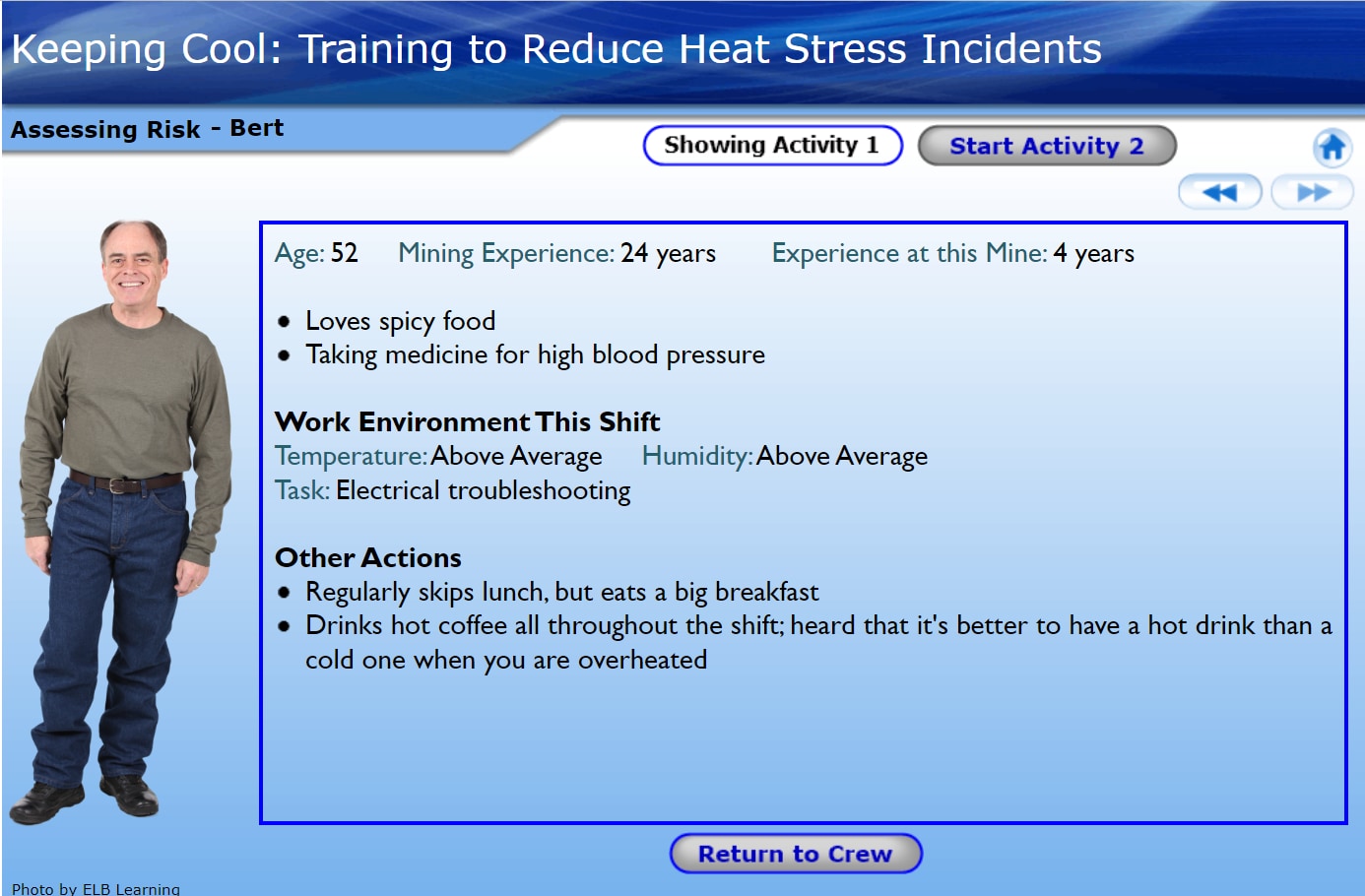Mining Publication: Technology News 565: Keeping Cool: Training to Reduce Heat Stress Incidents in Mines
Original creation date: August 2023
Authors: B Connor
Pittsburgh, PA: U.S. Department of Health and Human Services, Public Health Service, Centers for Disease Control and Prevention, National Institute for Occupational Safety and Health, DHHS (NIOSH) Publication No. 2023-138 (TN 565), 2023 Aug;
Summary
Keeping Cool is an instructor-led training module to reduce heat-related illnesses in miners. It is now available from the National Institute for Occupational Safety and Health (NIOSH). Safety trainers can use the module to guide discussions on (1) what on- and off-shift behaviors increase heat stress risk, (2) how to recognize the signs of heat stress in oneself and one’s coworkers, and (3) what first aid actions to take when someone has a heat-related illness. The module also includes a simple explanation of how heat affects the body, a short video testimonial to motivate action, an instructor’s guide, and fact sheets that managers can make available as on-demand job aids.
Background

Figure 1: Keeping Cool home screen showing links to two activity modules, two informational modules, and the instructor's guide
Miners working in hot environments—whether inside, outside, or deep underground—are at risk of illness and even death due to heat stress. Heat can affect workers differently and can even affect the same worker differently on different days [NIOSH 2018]. This could cause miners to misjudge the risk to themselves or their coworkers and fail to take suitable precautions or first aid actions. Miners need to recognize what actions and conditions put them at greater risk, what steps they can take to reduce their risk, and how to read and respond to the signs of heat stress in themselves or a coworker. Lectures are a common training choice, but they aren’t the best way to develop and practice skills [Clark 2015; Moore 2017]. Training with activities that engage learners leads to better learning outcomes and better transfer of learning into action [Ambrose et al. 2010; Dirksen 2016]. This is the approach taken by Keeping Cool.
Keeping Cool is designed to help mines reduce the number and severity of heat stress incidents. The module’s learning activities allow miners to practice assessing risk factors and identifying the appropriate response to heat stress in themselves or a coworker.
Developing the Keeping Cool Training Module
NIOSH developed Keeping Cool in response to safety managers’ concerns about heat stress incidents in deep metal mines. However, Keeping Cool can be applied to any mining environment.
NIOSH followed current research-based guidelines to design the learning activities [Ambrose et al. 2010; Clark 2015; Dirksen 2016; Moore 2017]. That research emphasizes (1) designing for behavior goals; (2) distinguishing what trainees must know from what they can look up later; (3) having learners apply what they know to solve realistic problems; (4) structuring activities so learners don’t have to wade through explanations they don’t need, but do have the opportunity to pull in extra information when they wish; and (5) guiding learners as they apply knowledge to new situations. NIOSH conducted field tests of the materials with miners working in underground metal mines and with miners working in surface stone and gravel mines. NIOSH then made refinements based on miner feedback.
How to Use Keeping Cool
Keeping Cool includes four units: two risk-assessment activities, a video testimonial from a victim of heat stress and his supervisor, and a brief primer on how excessive heat affects the body internally.
The core of Keeping Cool is its first two activities, which ask trainees to assess a crew of miners. Trainees identify heat stress risks, evaluate symptoms, and recommend appropriate first aid measures.
The instructor’s guide details the heat-related illness and first aid associated with each crew member. Trainers should familiarize themselves with this material and the included NIOSH fact sheets prior to leading the activities. To customize the class, trainers can choose specific crew members to evaluate or design their own.
These activities should be completed before trainers provide any information on heat stress. This approach requires trainees to apply prior knowledge, which promotes learning better than passive listening or looking up answers. Instructors can provide trainees with the NIOSH fact sheets to assist with their task of evaluating crew members. In field tests, miners shared their knowledge with each other during small group and class discussions.
The training can be run with any size group. However, in field tests, it worked well to create breakout groups of three to five miners each. Small group discussions gave trainees the chance to raise questions and even make mistakes in a low-stakes setting. Instructors can present the units separately or in one session. In field tests with classes of approximately 15 miners divided into four small groups, running the entire set took about 45 minutes.
How to Get Keeping Cool
Keeping Cool is available for free on the NIOSH Mining website.
References
Ambrose SA, Bridge MW, DiPietro M, Lovett MC, Norman MK [2010]. How learning works: seven research-based principles for smart teaching. San Francisco, CA: Jossey-Bass.
Clark RC [2015]. Evidence-based training methods: a guide for training professionals. 2nd ed. Alexandria, VA: ATD Press.
Dirksen J [2016]. Design for how people learn. 2nd ed. San Francisco, CA: New Riders.
Moore C [2017]. Map it: the hands-on guide to strategic training design. Montesa Press.
NIOSH [2018]. Heat stress: understand heat stress risk factors, prevention, and treatment. Poster. Spokane, WA: U.S. Department of Health and Human Services, Centers for Disease Control and Prevention, National Institute for Occupational Safety and Health, DHHS (NIOSH) Publication No. 2018-116.

Pittsburgh, PA: U.S. Department of Health and Human Services, Public Health Service, Centers for Disease Control and Prevention, National Institute for Occupational Safety and Health, DHHS (NIOSH) Publication No. 2023-138 (TN 565), 2023 Aug;

